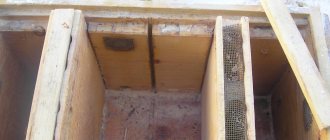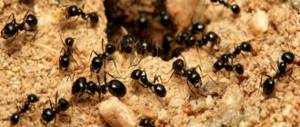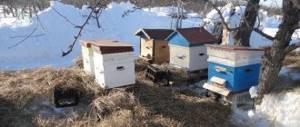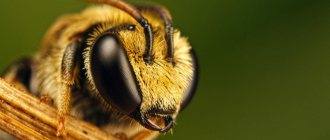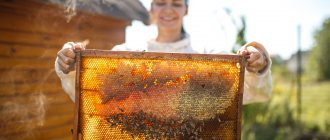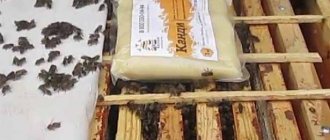Bees' home
Ground bees, true to their name, live in the ground. They themselves are not very willing to dig holes for themselves; they often use those free from rodents. They live in a swarm and build a home for themselves, only inside. One queen begins:
- Finds a suitable place.
- They build a hole and make a series of rooms.
- Leaves are placed on the bottom.
- Lay the first layer of eggs.
- They take care of the nutrition of the first generation.
- Nectar is placed in special chambers.
What earth bees look like: description and photo
Ground bees are wild insects that live underground. They build a whole system of tunnels and cells.
They live all over the globe, except, perhaps, South America, Madagascar, Australia and Oceania.
Insects have a thick black cover. The head is dark brown or black, and the wings are lilac or dark purple.
There may be patches of yellow on the belly, jaws and upper lip. In the chest area the fur is gray in places.
An adult female reaches a length of about 2 cm, and a male reaches 1.5 cm.
Honey production
Bees living in the ground remain bees. They live for one season, but store honey. There are a lot of people who want to get it, wild honey. The production process goes like this:
- Bees collect nectar;
- transferred and fermented;
- placed in wax honeycombs;
- sealed.
Lovers of wild honey from earth bees try in every possible way to get it - they steal their tunnels, for which they immediately become brutally bitten.
Character of bees
Ground bees are not harmful at all and have a calm character. But they can sting when it is necessary to protect offspring or their own territory. Their bite will not cause more trouble than the bite of other types of bees. Torment is caused only by manifestations of allergies in those people who are prone to it.
If you are bitten by a ground wasp, you need to:
- Remove the sting by carefully prying it up with tweezers or your fingernails.
- Disinfect the bite site with alcohol, brilliant green or peroxide.
- Treat with antihistamine cream.
Ground bee.
When to worry:
- if you have a tendency to allergies;
- if the bites were numerous;
- when the place was on the lips, larynx or tongue.
Common types of ground bees
Many species are representatives of the Red Book. They encountered people so often that they are now endangered. But there are some species that still occur periodically.
Andrena Clarkella
Andrena Clarkella.
A bee with a lot of fur, which makes it look like a bumblebee. The hind legs of this species are distinctively beautiful and prominent - they are densely covered with red hair.
They have a clear difference between the sexes: females are larger, rounder, and have a sting. Males, on the contrary, are thinner and have long antennae.
Leaf cutter
Leaf cutter bee.
A representative of solitary creatures that finds a place for a nest in the trees. It is very easy to notice their effect - they cut the leaves evenly or in a rounded shape.
These bees have a short lifespan - 2 months for the female and a month for the male. The parents mate, prepare the place, lay eggs and prepare shoots, and then die.
Woolbeaters
Little bees that love to live under the bark in trunks. These are frequent guests of botanical gardens and public gardens. They use wood to make cozy nurseries for children. They look very nice.
Woolbeaters.
Types of earth bees with photos and descriptions
Ground bees are actually not that rare. They are divided into several types, differing from each other in size, color and structure:
- Andrena-clarkella. One of the most common types. They live all over the world. The size varies from one centimeter to two centimeters. The color can be black, blue and, less often, orange. There is fluff on the head and back.
- Andrena Magna. This individual lives only on the Black Sea coast. The fur is black, sometimes there are yellow spots on the back, and the wings are dark purple. It reaches an average length of 1.5 centimeters. There is fluffy, coarse hair on the head.
- Galikt sphecodex. The smallest bee. The length of such an individual rarely reaches 1.5 centimeters. The shape resembles a wasp. A distinctive feature is the reddish color with a metallic sheen. Very rarely there are individuals with green fur.
- long-whiskered bee. Lives mainly in Europe and Kazakhstan. The body has a gray-red color. Distinctive features are long thick antennae and small body size.
- Woolbeaters. Among all types of underground bees, wool bees are the laziest. They never build their own homes, but use other people's. The insect is slightly plump, has a brownish color with yellow spots on the back. Males of this species are aggressive.
- Leaf cutters. The peculiarity of this species is that they do not produce honey at all. In appearance, leaf cutters are similar to a regular honey bee. But unlike them, they lead a solitary lifestyle. After laying eggs they die immediately.
- Nomad. They are similar in appearance to ordinary bees, but they do not have a device for collecting pollen. Their body is not covered with hairs. They do not build their own homes. But they throw their eggs into the houses of other underground bees. For this, the nomads received the nickname “cuckoo”.
- A carpenter. Singles. They have a unique black color, wings and eyes of a rich blue color. They buzz very loudly.
Neighborhood with earth bees
You need to start methods of dealing with earth bees with one question - is it worth expelling them? They do not live in large colonies and usually do not cause trouble.
Benefits of Ground Bees
Ground bee.
They pollinate flowers and trees well. Small animals store a lot of food for their offspring, and since their life span is short, they do this intensively and very actively.
Ground bees love alfalfa, which ordinary bees do not like. Colonies, especially leaf cutters, cope with this task very well and are even lured specifically for this purpose.
How to get rid of neighbor's earth bees
Insects that have settled in the neighborhood can also cause a lot of trouble.
If for some reason the neighbors do not get rid of them, you can use several tricks:
- Build a solid fence of polycarbonate or corrugated sheets 2-3 m high. An expensive but effective method. The bees will have to climb high up, and they will fly over the area.
- Plant plants that insects do not like in several places: peppermint, wormwood, lavender, lemon balm.
- Treat the areas most liked by the swarm with a decoction of citrus fruits. To do this, you can pour boiling water over lemon or orange skins and boil.
Be sure to read:
What to do if you are bitten by a bee: first aid, how to relieve swelling and redness, the best remedies
How to deal with earth bees
If you decide to start fighting bees, then you need to determine the method and prepare yourself. All measures must be taken taking into account safety requirements.
There are several basic ways to control insects.
Water
Boiling water works best and most effectively. Depending on the size of the nest, several buckets of water will be needed. They are quickly poured out and the entrance is closed with a stone. Repeat if necessary.
Fire
Any flammable liquid can be used. It is poured into a hole that the bees use as a nest and set on fire. This method should not be used near a barn or buildings. Beware of angry bees.
Poison
Special preparations that serve as poison will help get rid of earth bees. There are many of them on sale, produced in various forms. They spray the nest with them and close the entrance so that they do not fly out.
If necessary, a number of procedures must be repeated. After the nest is destroyed, the place is dug up.
What you need to know about security
Ground bees are dangerous representatives of the species. Although they themselves do not attack on a whim or of their own accord. But in case of danger, they will launch their attack.
When working with bees, you must follow safety precautions:
- Wear a protective suit when working to protect against bees.
Protective suit for working with bees.
- It is better to work in the dark, when insects are less active.
- Chemicals should be diluted and used strictly according to instructions.
- If insects begin to attack, it is better to flee. They attack as a whole group very easily and quickly.
- During work, protect children and pets, even warn neighbors.
There are wild bees in the area
The best way to get rid of a wild swarm is to ask a beekeeper.
However, you can get rid of it yourself. The main thing is to wear a protective suit:
- light in color and made of dense material;
- with thick gloves (you can use rubber ones);
- with a mosquito net to protect your head (you can wear an additional hat under it, in case the fabric gets bitten).
After that you can start. We get rid of flying enemies using one of these methods:
Move bees to another location
You can take pity on the swarm and move it to another area.
It is better to get rid of it in the evening, when the insects have just returned from honey collection. They need to be smoked with a smoker.
Then the clumsy and “loaded” with honey insects (therefore not biting) will run to escape. All that remains is to get rid of the honeycombs by moving them away.
Destroy their home
The queen bee always remains in the nest. If you destroy it and the larvae, the rest of the family will die.
Here's how to do it:
- Using smoke or fire. This option is suitable if the nest is in a fireplace or chimney.
- Boiling water. Or liquids like diesel/gasoline. It is convenient if the bee houses are located in the ground or hollow.
- Insect repellents. They are called insecticides. “Dust” for cockroaches will do.
When to attack: If the nest is in an easily accessible place - on a clear sunny morning, when the insects go to collect honey. If in a hard-to-reach place, late in the evening, when the entire bee colony will gather in one place and will not be able to attack from the air.
How to secure the site
Typically, earth bees do not cause much trouble or harm to people. Their small family usually settles close to a food source and does not interfere with human habitation. But they happen; they are attracted to gardeners without knowing it.
Honey plants are very popular with bees, who prefer to feed on their pollen and nectar. A large number of them will attract Hymenoptera.
Accordingly, it's the other way around. There are those plants that repel insects with their smell. These include:
- lavender;
- calendula;
- basil;
- Melissa;
- sagebrush;
- mint.


